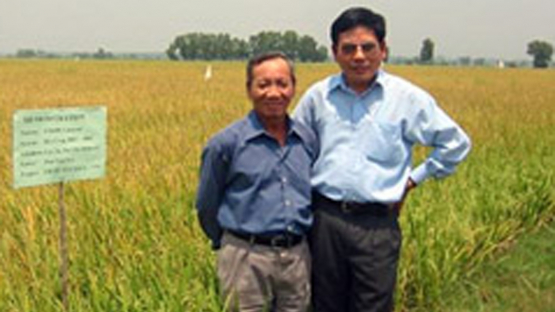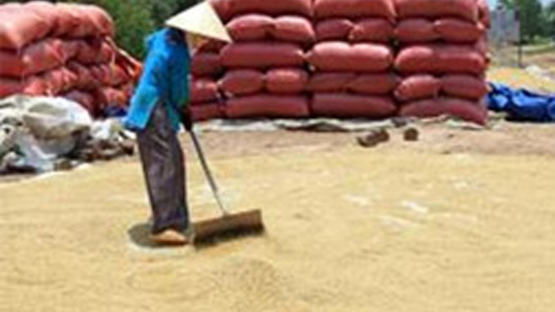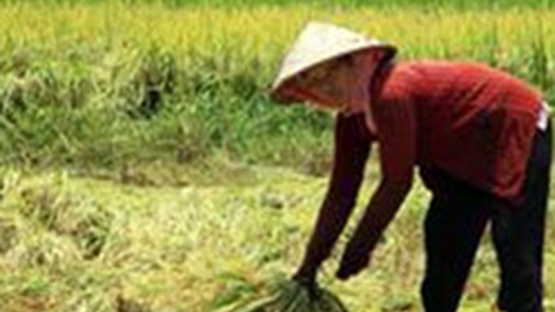More than 50 mutant varieties were developed, in which most of the varieties are cereal crops, especially rice. At present, about 15% of the rice production area is covered annually by mutant varieties in Vietnam. Since the 1980’s, the Agricultural Genetics Institute (AGI), Vietnam Academy of Agricultural Sciences (VAAS), has been engaged in R&D activities and contributes much to the technology transfer to the agricultural sector of Vietnam. Mutation breeding is one of the major fields of the Institute in crop improvement, in which the biggest accomplishments have been achieved in the development of mutant varieties for crop production.

If you would like to learn more about the IAEA’s work, sign up for our weekly updates containing our most important news, multimedia and more.
Successful Mutation Breeding Programmes in Vietnam
Mutation breeding has become the most successful field of application of nuclear techniques in food and agriculture: more and more mutant crop varieties, especially in rice have been released to farmers and make great contributions to local and national food security.
The outcome of the IAEA TCPs and CRPs has substantively increased the capacity of Vietnam and further contributed to improved national food security.
Vietnamese Government officials expressed their sincere expectation for the extension of outcome based cooperation with the IAEA through the integrated application of mutant crop varieties with good agricultural practices (efficient soil and water management), which indeed shows a great potentiality: the IAEA, through the Joint FAO/IAEA Centre, can continue to contribute to improve national food security in order to achieve sustainable agricultural production not only in the field of mutation breeding but also in other areas, such as efficient soil and water management practices, livestock production and the control of transboundary animal disease.

Fig. 2 - Mutant rice varieties are part of the national poverty alleviation programme of Vietnam ( Photo courtesy of Q. Liang, NAFA)

Fig. 3 - Mutant soybean trials (Photo courtesy of Q. Liang, NAFA)
With support from the IAEA through TCPs and CRPs, 30 mutant varieties were developed and released officially to farmers for their production, including 17 rice cultivars, 10 soybean varieties, two maize varieties and one chrysanthemum variety. Most of these crop varieties are high yielding with insect pest resistance, disease resistance/tolerance and high quality. More than 50% of the soybean cultivation area is covered by mutant varieties developed in the Institute, which is contributing to oil crop production of Vietnam. The application of modern biotechnology, such as tissue culture and molecular marker-assisted-selection methodologies, are increasing the efficiency of mutation breeding.
In the well organized and conducted trials of soybean mutant lines in the Vietnamese experimental fields and production farms, several mutant lines are well out-performing local control varieties. Based on the results of trials in the past few years and their field performance, it is expected that more mutant varieties will be released in the coming years.

Fig. 4 - High yielding mutant rice varieties are being widely cultivated in remote mountain areas for the profit of poor farmers (Photo courtesy of Q. Liang, NAFA)
The Institute of Agricultural Science of South Vietnam (IAS) in Ho Chi Minh City is the oldest national research institute founded in 1925 and has more than 450 staff. The Institute was organized into 11 research departments, seven applied research centers, one laboratory of high technologies and three supporting offices. IAS plays an important and leading role of R&D activities for agriculture and rural development in Vietnam. The institute has also succeeded in mutation breeding by use of nuclear techniques and related biotechniques. Over the past decade, the Institute has developed eight excellent mutant rice varieties with high yielding, improved quality, disease resistance, tolerance to pests and lodging resistance. Since 2008, the total cultivated area of these mutant rice varieties was more than 2.54 million ha in Southern Vietnam.
According to the statistics from the Institute, these mutant rice varieties have increased income by about $374 million at the end of 2008 (according to governmental officials, 1 US$ investment leveraged 800 US$ return). One of these excellent mutant rice varieties (VND9S-20) become one of the top five varieties for export rice production. It covered the largest cultivation area of rice production in Southern Vietnam in 2007 and recently was grown on more than 300 000 ha per year in South Vietnam, due to its high yielding, good quality and tolerance to brown plant hopper. Not only has this variety been widely cultivated in the lowlands, but also expanded to the highlands and remote mountain areas, where poor farmers are benefiting from growing it.

Fig. 5 - Demonstration plot for rice in Vietnam - TC project VIE/5/014: Rice farmer (left) is happy with rice breeder (right) at the Institute of Agriculture in Southern Vietnam: a short duration mutant variety means an extra crop harvest of rice a year! (Photo courtesy of Q. Shu, NAFA)
It is very clear that it is the great support form the Vietnam Government that makes the application of nuclear techniques in food and agriculture so successful. Due to the excellent performance of the mutant rice varieties mentioned above, some of these mutant varieties were adopted for the Vietnam national strategy program of “Eradicate hunger and alleviate poverty” in different areas, particularly for central highland region of Vietnam, where there are many ethnic minorities living in remote mountain areas. The central highland region of Vietnam has a natural area of 5.5 million ha, population of 4.3 million with 37 different ethnic peoples. This region is an under-developed poor area where the agricultural production is vulnerable and unsustainable.
With the joint support of IAEA and Vietnamese Government, a project for yield trial and demonstration of mutant rice varieties was carried out in Buon Me Thuot, in order to evaluate and identify the mutant varieties adapted to local conditions for extension production.

Fig. 6 - Mutant varieties' outstanding performance under local production conditions ensure sustainable food security (Photo courtesy of Q. Liang, NAFA)
Most of the eight mutant varieties have shown outstanding performance under local production conditions. These promising varieties were identified in the trials with improved characters, such as high yielding, increased disease and insect resistance/tolerance, short growth duration, good quality and better adaption to environment stress. Some of mutant varieties (VND 95-20, VND 99-3 VN121) have increased more than 30% of yield, compared to the control of the local variety. These mutant varieties have been well accepted by local farmers and will be cultivated in expanding areas. Thus, the farmers themselves express their appreciation of mutant varieties for their contribution in increasing yield and income for poor formers.

Fig. 7 - Local farmers obtain maximum yield potential of mutant varieties (Photo courtesy of Q. Liang, NAFA)
In order to help local farmers increase intensification of rice production, and obtain maximum yield potential of mutant varieties, IAS and the local government have made great efforts in technical transfer through a series of training courses in the field. These training courses have focused on rice cultivation techniques, good fertilization practice, efficient water management and proper use of pesticides for the purpose of sustainable rice production. It has been proved that the farmers have extensively benefited from the techniques transferred through these training courses.


